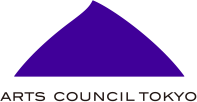Series: The future of arts and culture-driven well-being
“Well-being” refers to a positive state in terms of mind, body, and society.
Under the supervision of Dominique Chen, we present a three-part special edition on arts and culture-driven well-being in the era of life under coronavirus.
2021/02/05
A dystopian future and well-being
Artist
Ai Hasegawa
Series: The future of arts and culture-driven well-being
“Well-being” refers to a positive state in terms of mind, body, and society.
Under the supervision of Dominique Chen, we present a three-part special edition on arts and culture-driven well-being in the era of life under coronavirus. Our contributor for part three is artist Ai Hasegawa.
Research in a variety of fields including cognitive psychology and education has studied how creative expression in a broad sense affects well-being. Contributing pieces to this series are Junko Shimizu and Ai Hasegawa, whose work is on show in the “traNslatioNs” exhibition directed by myself at 21_21 DESIGN SIGHT. In their columns they look at the arts and well-being from the perspective of being personally involved in the expressive field.
Our two contributors, who continue to expand the boundaries of art and design, have provided us with a wealth of pointers as to ways in which the act of creative expression constitutes well-being. Junko Shimizu details the process of deepening awareness of the self and of others by connecting listening and looking through her experience of the practice she calls “graphic recording.” Ai Hasegawa maintains that she was able to set herself free by positioning her own struggles and despair at the heart of her creative work. What their perspectives have in common is the belief that creative expression encourages change in the relationships we have with ourselves and the people around us.
These insider perspectives lead us to the realization that creative expression means learning. This encourages us to focus not only on the results of fixed forms of expression but also on changing processes, in which case it becomes necessary to find well-being factors within the process of change. I hope readers will join us in considering this matter.
Dominique Chen
Whenever I hear about well-being, I always remember this passage about the word “flourish” in an article I read by Dominique Chen.
“Flourish” in English is a verb meaning “to flower” with the noun form “flourishing.” This is fairly close in nuance to “the blooming of talent,” and we can say that it refers to a condition of spiritual fulfillment in which we are able to fully exercise our capabilities.
Source: https://lexus.jp/magazine/20170519/1/tec_dominick_01.html
I also remember these words when I think about “happiness” beyond things such as eating delicious food, going to nice places, watching enjoyable movies, etc.
Over ten years ago I was depressed. I should have been happy, having a wonderful partner and living in London, but I was doing a job that didn’t suit me and knowing I was mildly depressed made it harder to get out of. After that, I split up with my partner for various reasons and was finally able to review my life, so I enrolled in London’s Royal College of Art and began to look for something that only I could create. I met a teacher who found value in, and encouraged me to develop, ideas I had timidly put forward before but not believed in, so I managed to turn my ideas into a work and put it out into the world; and when I received a certain amount of recognition, I felt an enormous sense of fulfillment. I’m basically really bad at contacting people and asking for things or putting plans together, so there are some aspects to creating work I dislike aside from research. To get over that weakness, look at a work with my own negative feelings about it removed, and refine it from a different perspective are things I find incredibly difficult, but I think the word “flourish” is appropriate here. I don’t think it’s any exaggeration to say that what should be taught at elementary school as the purpose in life is not getting married or getting rich, but how to help the talents and abilities inside of you flower.
Well-being through the creation of art
Through creation I was able to “flourish,” which gave me confidence and got me out of depression; and another aspect to creation is the way it “prescribes painkillers” and “breaks the curse” in the search for “freedom.”
By introducing perspectives from different angles, art and culture can reframe problems, giving us ideas for solving the problems that tie people down. Take my project “I Wanna Deliver a Dolphin…”(2011- 2013), for example: for me at the time the idea of giving birth to a child was extremely problematic; it seemed sinful to give birth to a human being but on the other hand I couldn’t give in to the option of not giving birth. So, what I was proposing in this work to the viewer as well as to myself was that if you like the idea of an alternative to giving birth to a human child, and you like encountering marine life on a dive, why not become a surrogate mother to an endangered species?
I was raised in a society with cultural values that say a happy woman is one who wants to meet a great guy, fall in love and give birth to a healthy baby. But I questioned whether that was really the case, considered the existence of alternative values, and furthermore thought about the sort of technology that would make this possible. I think I am in the process of freeing myself by constructing hypotheses, presenting them in visual form, and breaking the curse on me through a process of self-questioning.
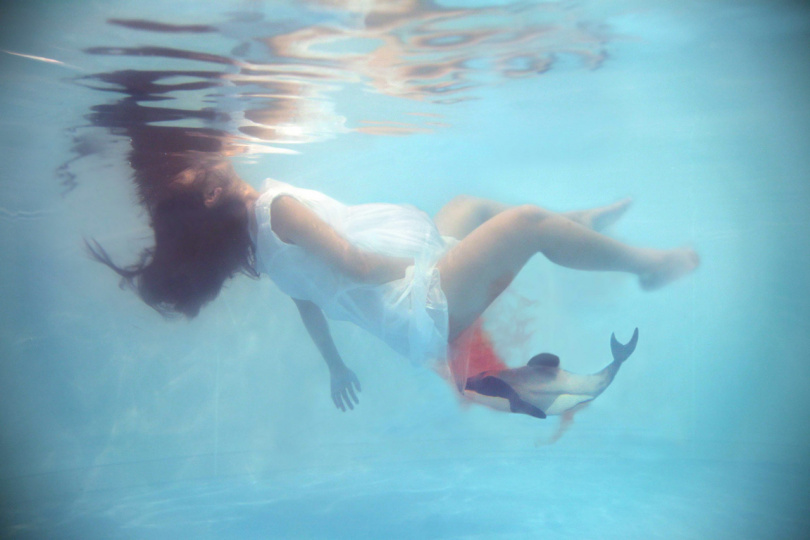
“I Wanna Deliver a Dolphin…” (2011 – 2013)
For the project “Human X Shark” (2017- ) I am in the process of developing a fragrance which makes women stronger and attracts male sharks. This work comes from my pain and despair that the gulf between people is still so deep despite the existence of language and words, or rather that despair from the expectation of mutual understanding is unbearable, so in this project I suggest it might be more romantic and joyous to connect with a creature that seems impossible to communicate with. Of course, there are many layers to the challenges involved with this concept, but in my work I tend to put forward the image of something somewhat roughly in its no-frills form, in order to loosen the constructs in the mind of the viewer as well as of myself.
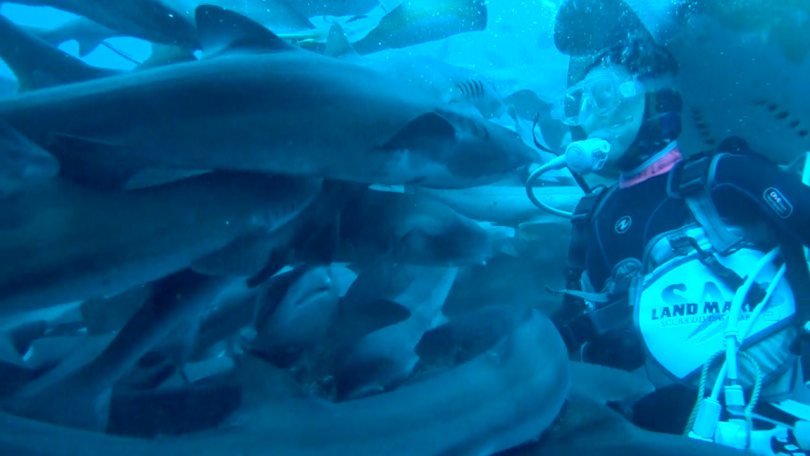
“HUMAN X SHARK” (2017-)
Arts, culture and well-being when a state of emergency normalizes
I’ve tried to imagine the future in my own way, but there are so many different troubles including conflict and division between various people, abnormal weather and environmental issues that unfortunately it is difficult to forecast anything that might brighten the future of Japan, and the reality is one of a dark future. Furthermore, there is also the possibility of the problems I cite above being multiplied by more problems. For example, the proliferation of coronavirus and earthquakes in Turkey in 2020.
This is why, when thinking about “the future of well-being,” I wonder how we can create a culture that puts a positive spin on migration as “travel” or “workation” when people are forced to move from the place they know due to multiple disasters and constant, frequent calamity; and how we can increase the number of communities who experience well-being this way through being able to respond effortlessly and flexibly to change, such as being able to work anywhere without being tied to where they are. Why do we believe “settled living” and our present culture of habitation to be good in the first place? It may be a good time to re-examine what we think with these beliefs as a starting point, and conduct thought experiments to redesign our daily lives and life in a broader sense.
Well-being of social minorities
In the past I used to love living alone, but after living in a shared house for several years I fell in love with communal living as something enjoyable that brings together an array of foods and talents. So when I think of survival in the dark future ahead of us, I see the involvement of multiple people as upping the scale in terms of what can be made and what can be done, and making life more fun. Of course, the important point is how we can create and maintain good relationships in a group.
In the design of a society in which many people live together, we need to emphasize the existence of minorities. Social minorities, vulnerable members of society. It may not have any direct bearing on you at the moment, but the design of our society is becoming increasingly important considering how in future you yourself might become a vulnerable member of society as a result of various troubles such as natural disasters and disease.
Depending on the type of people involved, sometimes technology may be developed in a way that is detrimental to specific groups, something which has already given rise to a variety of issues.
For example, I don’t mean to brag but my project “Alt Bias Gun” (2018-) looks at the combination of racial discrimination and technology, and the resulting society and lifestyle. When you think of the combination of “weapons” “government” and “facial recognition AI technology” negative scenarios come to mind such as genocide by algorithm, but I still think that we can think about positive usage as a result of taking on the challenge of using technology in a positive way. So for the project “Alt Bias Gun,” I came up with a mechanism in which a camera on a gun recognizes the faces of people likely to be shot by police, setting off an alert designed to question whether you are about to shoot through bias or prejudice, and activating a stopper to temporarily lock the trigger.
“(Im)possible Baby”(2015) is a project created in response to the situation in Japan where women are unable to participate in decisions on technological developments related to sexuality and reproductive health, or meetings and decision-making on their implementation in society, despite these being issues that directly involve women themselves. The project was designed to get us thinking impartially together about a series of ethical issues, such as whether gender discrimination and gender bias at the ethical decision-making level is preventing the development of minority-oriented reproductive technology; whether it is right for same-sex couples to have children or not, and why; and who makes these decisions.
The way new technologies are developed and used will change dramatically depending on who is involved, and a result our lives and social structure will change.
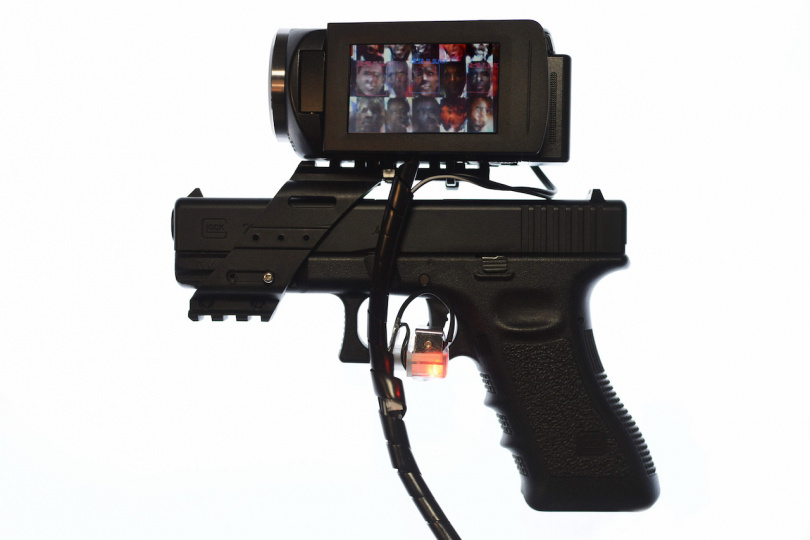
“Alt Bias Gun” (2018-)
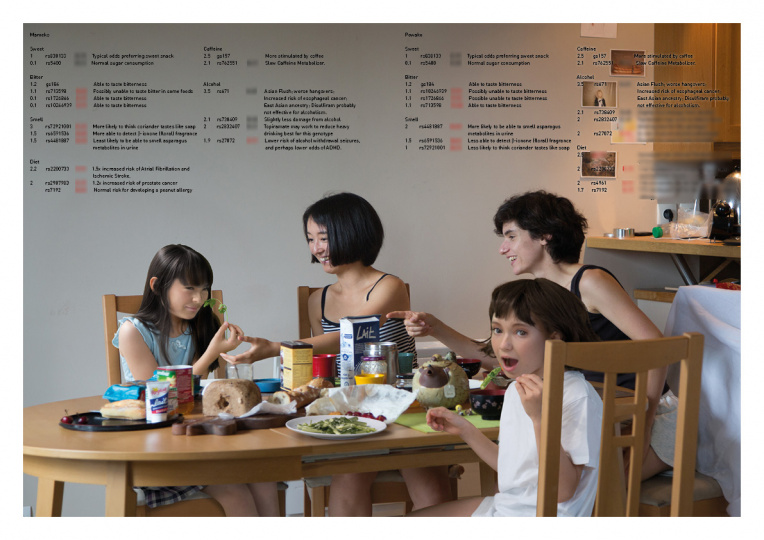
“(Im)possible Baby” (2015)
The emergence of the nomadic techno hippie in a state of well-being
Can you imagine living a happy life in our dystopian future? It’s a difficult question, so let’s look at a past precedent. If you look for a culture from the past in which a large number of people moved from place to place living happily without being too reliant on consumer culture, hippie culture comes to mind. The hippie culture of the past faced challenges in terms of a lack of economic power and sustainability due to its rejection of consumer capitalism, combined with the difficulties of managing communities that brought together large numbers of people, and conflict with conservative local people (you can learn more about this in the Netflix documentary “Wild Wild Country”).
How can we overcome these problems? For example, what if we could make food, clothing and housing self-sufficient by using new manufacturing and food production technologies that combine DIY bio and IoT?
In terms of community management, we could use community management tools based on information technology associatively connected to psychology and neuroscience, the dream being a society connected by a variety of relationships, a society in which people come and go in a wide variety of open and informal communities rather than belong to a single community, straddling multiple communities and moving around depending on the direction they want to grow in and their mood at that time.
Since arts and culture encourage us to consider things from multiple perspectives, such a society would surely work like fertilizer on them, making them flower. Problems tackled according to a binary A or B approach will also have C and D as possible paths to resolution, and the way we use technology and wisdom to effortlessly remove the veil of preconceived ideas that has been drawn over our minds without our knowing it will constitute the creativity that will liberate us.
The clever use of arts and culture to dismantle the self and reassemble at will. If we could only build a radical mentality and social system that could keep up with the radical changes to our environment. These days, above all I dream of the flowering of a new culture along these lines, of the nomadic techno hippie in a state of well-being who makes it through dystopia with a light heart.
aking as its theme biological issues and the advances of science and technology, Hasegawa’s work unearths the various latent problems of contemporary society. She received an MA from the UK’s Royal College of Art in 2012 and an MS from MIT Media Lab in 2016. From 2017 to 2020 she was a Project Researcher at the University of Tokyo and began working as a part-time lecturer at Waseda University in 2019. Since 2020 she has been a Project Researcher at Jichi Medical University and Kyoto Institute of Technology. “(Im)possible Baby” garnered an Excellence Award in the Art Division of the 19th Japan Media Arts Festival. Her work has featured in numerous exhibitions in Japan and overseas including at Mori Art Museum and Ars Electronica. Publications include “Revolutionary 20XX:speculative design class.”
Related Article
Series: The future of arts and culture-driven well-being
- A world we can envisage through the pictorializing of listening
Junko Shimizu (Design researcher) - The future of arts and culture-driven well-being
Dominique Chen (Associate Professor at Waseda University, School of Culture, Media and Society since 2017)

